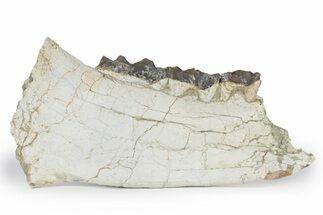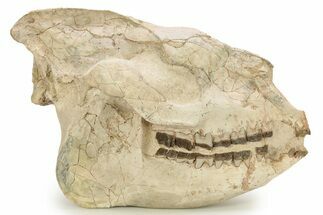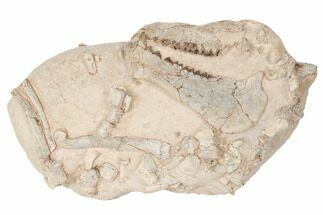This Specimen has been sold.
1.67" Fossil Early Ungulate (Cainotherium) Jaw - Quercy, France
This is a 1.67" wide jaw section (mandible) from an Oligocene ungulate, Cainotherium. The jaw contains 5 well-preserved teeth.
This genus of prehistoric ungulates was roughly the size of modern rabbits and may have eaten in the same fashion as a rabbit would, despite the presence of canine-like teeth. In addition to eating like a rabbit, skeletal evidence suggests that Cainotherium may have hopped in a similar fasshion to rabbits. Cainotherium grazed throughout Europe from the Eocene into the Miocene epoch, about 56-20 million years ago. These herbivores were in the same suborder as modern Camelids and Oreodonts, but were smaller in stature than those species.
The Quercy Phosphorites Formation in France is world famous for its Eocene to Miocene faunas, especially those from the upper Eocene to lower Oligocene. The latter particularly helped to understand the ‘Grande Coupure’, a dramatic faunal turnover event that occurred in Europe during the Eocene-Oligocene transition. Fossils from the Quercy Phosphorites were excavated during the mid-19th century until the early 20th century from a series of sites that are no longer accessible. These fossils have subsequently dispersed between several research institutions, unfortunately losing some temporal and geographical information in the process. This material is part of an old collection we acquired that presumably was collected along with this material in the 19th or early 20th century. A recently published paper on the mammals of the Quercy Phosphorites can be found below.
The upper Eocene-Oligocene carnivorous mammals from the Quercy Phosphorites (France) housed in Belgian collections
The upper Eocene-Oligocene carnivorous mammals from the Quercy Phosphorites (France) housed in Belgian collections
SPECIES
Cainotherium sp.
LOCATION
Lot (Formerly Quercy), France
FORMATION
Quercy Phosphorites Formation
SIZE
1.67" Wide
CATEGORY
ITEM
#181290
We guarantee the authenticity of all of our specimens.
 Reviews
Reviews












